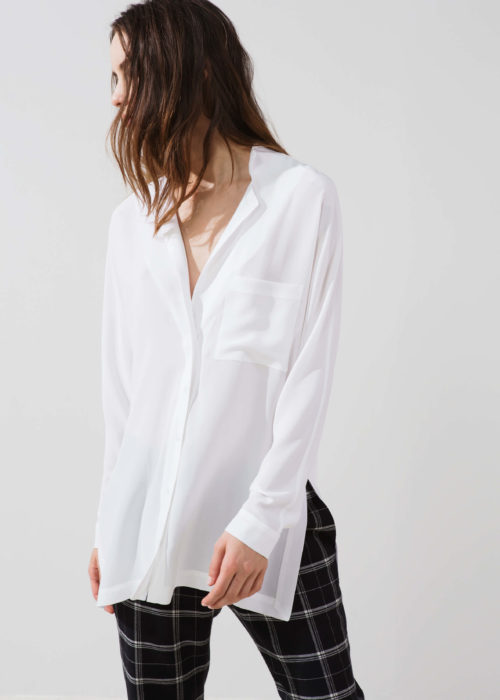As anyone who has even half-heartedly Googled “sustainable fashion” can tell you, making sense of the “eco-friendly” label is especially confusing when it comes to clothing, often producing more questions than answers: Should I be wearing vegan sandals this summer? Should all my t-shirts be organic? Do I need to donate all my yoga pants? Can I have a glass of wine now?
It can feel like we’re always balancing one downside versus another when it comes to shopping for sustainable clothing. Which, in fact, we are, since there is no such thing as a perfectly sustainable fashion choice, unless going naked is an option. But we're too shy for that! So at FAUBOURG, we embrace the messiness of trying to live consciously, even if that means imperfection. We believe in investing in responsibly made clothing that speaks to our individual sense of style because sustainability starts with great design and high quality materials. This often begins with a textile: a beautiful fabric that feels luxurious and meets our ethical standards. Below, in Part 1 of our guide to eco-friendly fabrics, find six we’ve fallen in love with:
NATURAL FABRICS
Alpaca: Alpaca is the new cashmere. Like its more famous cousin, alpaca is blissfully soft and light without the itchiness associated with coarser wools. However, while demand for low-priced cashmere has led to the over-breeding of goats, the desertification of Mongolian grazing lands, and some pretty crummy cashmere-blend cardigans, alpaca has emerged as a sustainable alternative. Peruvian alpaca goats are widely considered to be one of the greenest animals around, and, as an added bonus, their coats come in a spectrum of gorgeous natural colors, reducing the need for dyeing and processing.
Organic cotton: No cotton textile, organic or otherwise, is perfect. From an ecological point-of-view, the plant is extremely water-intensive, requiring more than 1,000 gallons to produce enough raw cotton for a single pair of jeans. However, conventionally grown cotton poses even bigger problems for the environment: the industry accounts for more than 10% of total pesticide use and nearly 25% of insecticides use worldwide. As an alternative, organic-certified cotton adheres to strict international standards that permit few agrichemicals—which is good not only for the planet but for the farmers growing the crop and those of us who wear it.
Silk:* The reasons to love this ancient fabric might begin with the practical—it’s lightweight, warm, breathable, durable, and washable. But silk’s whisper-soft feel and unrivaled elegance elevate it to heirloom status. Whether you’re throwing on a blouse, sliding into pyjamas, or zipping up an evening gown, there’s really nothing quite like it. Yet over the past several decades, polyester and poly-blend fabrics have proliferated as a cheaper, trendier, lower-maintenance alternative. These synthetic materials come with major ecological downsides, including the very problematic fact that like all plastics, they are not biodegradable—an issue that warrants increasing scrutiny in today’s fast-fashion culture.* A better silk alternative is rayon.
MAN-MADE FABRICS
Ready for some science? There are two basic categories of man-made fabrics: “plastics” and “cellulosics.” To understand the difference, think back to tenth-grade biology and see if the word cellulose rings a bell. It’s an organic material that occurs naturally in fibrous plants like cotton, hemp, bamboo, etc., and it can be chemically processed to create textiles. When cellulose is made into fabric, it’s called rayon. Rayon differs from plastic fabrics such as polyester because, although both are created through a chemical process, rayon is created out of botanical matter while polyester is created out of petroleum. Still with us? Good.
Modal and Tencel are the names of trademarked rayons. Along with Cupro, these fabrics are produced in a 'closed loop,' which means the chemicals used can be extracted (rather than dumped) after processing, and the water can be reused. Closed-loop fabrics are considered to have a lower environmental impact than other man-made materials, and lots of sustainable-fashion advocates consider them among the best choices for consumers. They’re also light and absorbent like cotton, they have a silky hand, and they drape beautifully.

Courtesy Vyayama
But if the process still feels overwhelming, at the end of the day remember that the best way to shop sustainably is to buy deliberately, investing in pieces that speak to you and which are thoughtfully constructed out of materials that will last. When you purchase a garment you truly love and will enjoy wearing repeatedly for years to come, you’re making a choice for style over fashion, and quality over quantity. Which is what sustainability is all about.
*Because silk is an animal product that traditionally involves killing the silk worm during the production process, some people avoid this material. Ahimsa silks (also known as “peace silks” or “cruelty-free” silks), which allow the worms to evacuate the cocoon before harvesting the silk, have become an accessible alternative.
**Much of the information for this article came from the books To Die For: Is Fashion Wearing Out the World? By Lucy Siegel and Overdressed: The Shockingly High Cost of Cheap Fashion by Elizabeth Cline. Both are excellent references for anyone wishing to learn more about sustainable fashion.
Words by Kerry Folan. Kerry is a writer and editor with a special interest in sustainable fashion. Her work has been published in the Washington Post, Racked.com, and Glamour.com, among other media.
MORE STORIES
-
MEET: Mengly Hernandez of LINEA Germania
-
5 Ways to Love Yourself Every Day
-
Five Minutes with Artist Maryam Ego-Aguirre
-
MEET: Carla Robertson, designer of eyewear brand Carla Colour
-
Conscious Gifts by and for Badass Women
-
3 Ugly Truths About Fast Fashion
-
5 Women of Color Changing the Way We See the World
-
October: 5 Ways to Spice Up Your Life & Style
-
MEET: Nicole Heim of New York Label Cienne
-
FAUBOURG Voices: Yomi Abiola





